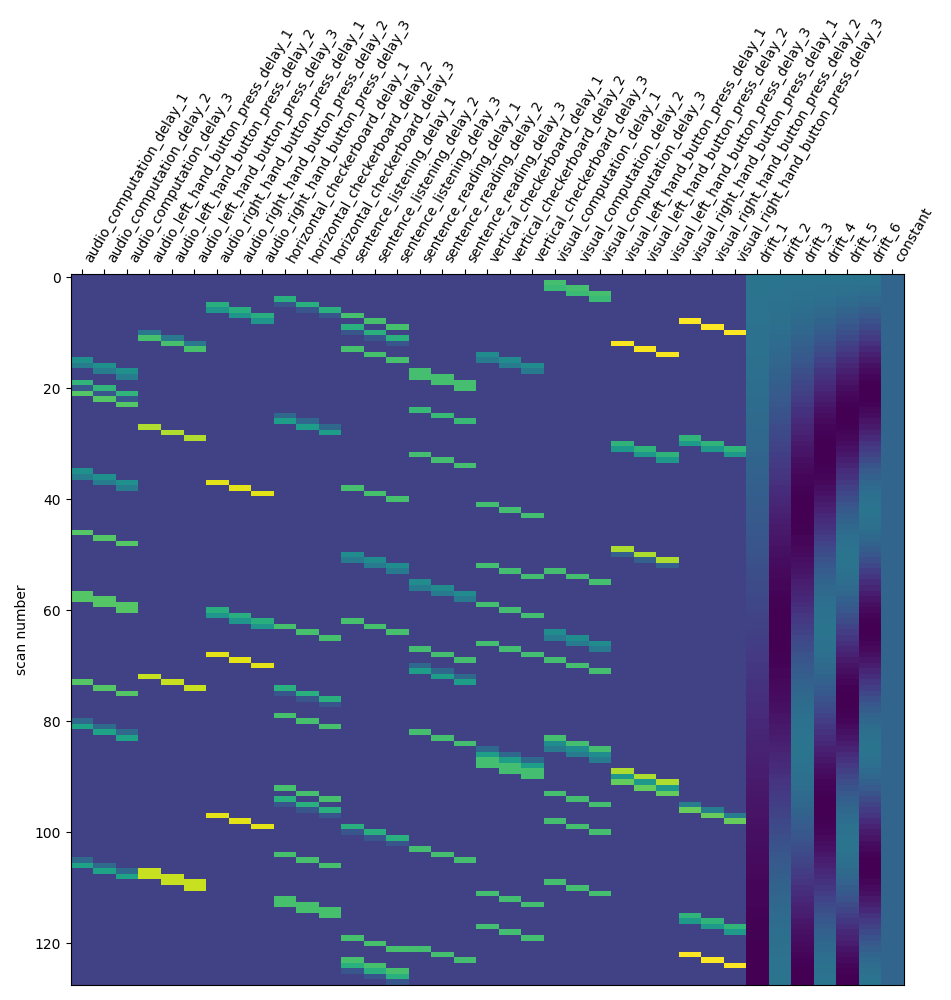Note
Click here to download the full example code or to run this example in your browser via Binder
Analysis of an fMRI dataset with a Finite Impule Response (FIR) model#
FIR models are used to estimate the hemodyamic response non-parametrically. The example below shows that they’re good to do statistical inference even on fast event-related fMRI datasets.
Here, we demonstrate the use of a FIR model with 3 lags, computing 4 contrasts from a single subject dataset from the “Neurospin Localizer”. It is a fast event related design: During 5 minutes, 80 events of the following types are presented : [‘audio_computation’, ‘audio_left_hand_button_press’, ‘audio_right_hand_button_press’, ‘horizontal_checkerboard’, ‘sentence_listening’, ‘sentence_reading’, ‘vertical_checkerboard’, ‘visual_computation’, ‘visual_left_hand_button_press’, ‘visual_right_hand_button_press’]
At first, we grab the localizer data.
import pandas as pd
from nilearn.datasets import func
data = func.fetch_localizer_first_level()
fmri_img = data.epi_img
t_r = 2.4
events_file = data['events']
events = pd.read_table(events_file)
Dataset created in /home/alexis/nilearn_data/localizer_first_level
Downloading data from https://osf.io/2bqxn/download ...
Downloaded 6299648 of 34532740 bytes (18.2%, 4.5s remaining)
Downloaded 12836864 of 34532740 bytes (37.2%, 3.4s remaining)
Downloaded 19816448 of 34532740 bytes (57.4%, 2.2s remaining)
Downloaded 25911296 of 34532740 bytes (75.0%, 1.3s remaining)
Downloaded 34275328 of 34532740 bytes (99.3%, 0.0s remaining) ...done. (7 seconds, 0 min)
Extracting data from /home/alexis/nilearn_data/localizer_first_level/62d16779cfae29f3623d6a194141d263/download..... done.
Next solution is to try Finite Impulse Response (FIR) models: we just say that the hrf is an arbitrary function that lags behind the stimulus onset. In the present case, given that the numbers of conditions is high, we should use a simple FIR model.
Concretely, we set hrf_model to ‘fir’ and fir_delays to [1, 2, 3] (scans) corresponding to a 3-step functions on the [1 * t_r, 4 * t_r] seconds interval.
from nilearn.glm.first_level import FirstLevelModel
from nilearn.plotting import plot_design_matrix, plot_contrast_matrix
first_level_model = FirstLevelModel(t_r, hrf_model='fir', fir_delays=[1, 2, 3])
first_level_model = first_level_model.fit(fmri_img, events=events)
design_matrix = first_level_model.design_matrices_[0]
plot_design_matrix(design_matrix)

<AxesSubplot:label='conditions', ylabel='scan number'>
We have to adapt contrast specification. We characterize the BOLD response by the sum across the three time lags. It’s a bit hairy, sorry, but this is the price to pay for flexibility…
import numpy as np
contrast_matrix = np.eye(design_matrix.shape[1])
contrasts = dict([(column, contrast_matrix[i])
for i, column in enumerate(design_matrix.columns)])
conditions = events.trial_type.unique()
for condition in conditions:
contrasts[condition] = np.sum(
[contrasts[name] for name in design_matrix.columns
if name[:len(condition)] == condition], 0)
contrasts['audio'] = np.sum([contrasts[name] for name in
['audio_right_hand_button_press',
'audio_left_hand_button_press',
'audio_computation',
'sentence_listening']], 0)
contrasts['video'] = np.sum(
[contrasts[name] for name in
['visual_right_hand_button_press',
'visual_left_hand_button_press',
'visual_computation',
'sentence_reading']], 0)
contrasts['computation'] = contrasts['audio_computation'] +\
contrasts['visual_computation']
contrasts['sentences'] = contrasts['sentence_listening'] +\
contrasts['sentence_reading']
contrasts = {
'left-right': (
contrasts['visual_left_hand_button_press'] +
contrasts['audio_left_hand_button_press'] -
contrasts['visual_right_hand_button_press'] -
contrasts['audio_right_hand_button_press']),
'H-V': (contrasts['horizontal_checkerboard'] -
contrasts['vertical_checkerboard']),
'audio-video': contrasts['audio'] - contrasts['video'],
'sentences-computation': (contrasts['sentences'] -
contrasts['computation'])
}
Take a look at the contrasts.
plot_contrast_matrix(contrasts['left-right'], design_matrix)

<AxesSubplot:label='conditions'>
Take a breath.
We can now proceed by estimating the contrasts and displaying them.
import matplotlib.pyplot as plt
from nilearn.plotting import plot_stat_map
fig = plt.figure(figsize=(11, 3))
for index, (contrast_id, contrast_val) in enumerate(contrasts.items()):
ax = plt.subplot(1, len(contrasts), 1 + index)
z_map = first_level_model.compute_contrast(
contrast_val, output_type='z_score')
plot_stat_map(
z_map, display_mode='z', threshold=3.0, title=contrast_id, axes=ax,
cut_coords=1)
plt.show()

The result is acceptable. Note that we’re asking a lot of questions to a small dataset, yet with a relatively large number of experimental conditions.
Total running time of the script: ( 0 minutes 19.981 seconds)
Estimated memory usage: 272 MB